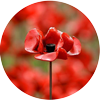 Standing silently in light drizzle at 7.30am on 1st July 2016, our group were taken back to the moment exactly one hundred years earlier, when whistles blew and the young volunteers of Kitchener’s New Army went ‘over the top’ to start the Battle of the Somme. The race was on. On one side were British troops, laden down with packs, rifles and equipment – walking slowly and deliberately in waves across no man’s land. On the other, German soldiers emerged from their bunkers and frantically assembled their machine guns. Tragically, only one side knew it was a life or death race, and what ensued was the bloodiest day in the history of the British Army. The British were mown down in their thousands.
Standing silently in light drizzle at 7.30am on 1st July 2016, our group were taken back to the moment exactly one hundred years earlier, when whistles blew and the young volunteers of Kitchener’s New Army went ‘over the top’ to start the Battle of the Somme. The race was on. On one side were British troops, laden down with packs, rifles and equipment – walking slowly and deliberately in waves across no man’s land. On the other, German soldiers emerged from their bunkers and frantically assembled their machine guns. Tragically, only one side knew it was a life or death race, and what ensued was the bloodiest day in the history of the British Army. The British were mown down in their thousands.
We developed the Somme walk for the Westminster Guides Association, and a rota of guides was set up to run the walk over the summer. London was over a hundred and fifty miles from the Somme, but it played a significant role in the battle. The walk set out to bring London’s role in the battle back to life, by drawing on some of the visual triggers that the streets of Westminster provide.
 The group began by hearing the story of the Civil Service Rifles training in the courtyard of Somerset House, before going to fight on the Western Front and then at the Somme. The walk acknowledged the Londoners who voluntarily left their desks to fight, while also remembering an increasingly fearful yet angry civilian population that had come under Zeppelin bombardment. It touched on Fleet Street’s complicity in hiding the enormity of the catastrophe on that first day, and on how the truth began to trickle out as hospital trains were met at London’s railway stations by a flow of ambulances that could not be staunched.
The group began by hearing the story of the Civil Service Rifles training in the courtyard of Somerset House, before going to fight on the Western Front and then at the Somme. The walk acknowledged the Londoners who voluntarily left their desks to fight, while also remembering an increasingly fearful yet angry civilian population that had come under Zeppelin bombardment. It touched on Fleet Street’s complicity in hiding the enormity of the catastrophe on that first day, and on how the truth began to trickle out as hospital trains were met at London’s railway stations by a flow of ambulances that could not be staunched.
Standing in Trafalgar Square, the walk harked back to the euphoric scenes of August 1914, when for those about to die there was still glory in war, but also remembered firebrands such as Keir Hardie and Sylvia Pankhurst who campaigned in the Square against the War. On Horse Guards Parade, looking towards the rear of 10 Downing Street and now accompanied by a film crew from ITV London News, the group heard about key decision-makers and members of the War Cabinet including Prime Minister Herbert Asquith and Lord Kitchener. On to Whitehall, and then Westminster Abbey, the group pondered the solemn emptiness of the Cenotaph and the Tomb of the Unknown Warrior, before remembering again the 19,240 brave young men who lost their lives on 1st July 1916.

Leave A Comment